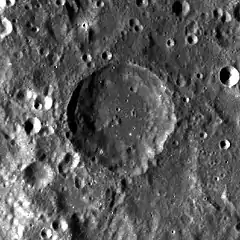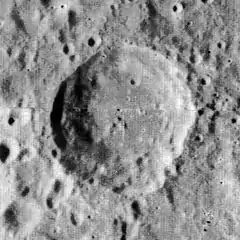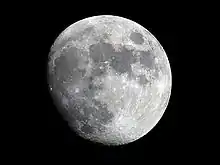Dewar (crater)
Dewar is a lunar impact crater that lies on the Moon's far side. Less than one crater diameter to the south-southwest is the crater Stratton. Vening Meinesz is a little over one crater diameter to the northwest. The slightly worn rim of this crater is roughly circular, with a small outward protrusion along the southern edge. The interior floor is marked by several small impacts along the eastern side.
 LRO image | |
| Coordinates | 2.7°S 165.6°E |
|---|---|
| Diameter | 50 km |
| Depth | Unknown |
| Colongitude | 195° at sunrise |
| Eponym | James Dewar |


Dewar lies on the south side of an anomalously low albedo area of terrain (dark patch) on the far side of the moon. The low-albedo area is also a geochemical anomaly, and is high in iron oxide and titanium dioxide. It has been interpreted as a cryptomare.[1]
Satellite craters
By convention these features are identified on lunar maps by placing the letter on the side of the crater midpoint that is closest to Dewar.
| Dewar | Latitude | Longitude | Diameter |
|---|---|---|---|
| E | 2.3° S | 167.8° E | 15 km |
| F | 2.8° S | 167.5° E | 14 km |
| S | 3.1° S | 163.9° E | 23 km |
References
- Lawrence, S. J., B. R. Hawke, J. J. Gillis-Davis, G. J. Taylor, D. J. Lawrence, J. T. Cahill, J. J. Hagerty, P. G. Lucey, G. A. Smith, and K. Keil (2008), Composition and origin of the Dewar geochemical anomaly, J. Geophys. Res., 113, E02001, doi:10.1029/2007JE002904.
- Andersson, L. E.; Whitaker, E. A. (1982). NASA Catalogue of Lunar Nomenclature. NASA RP-1097.CS1 maint: ref=harv (link)
- Blue, Jennifer (July 25, 2007). "Gazetteer of Planetary Nomenclature". USGS. Retrieved 2007-08-05.CS1 maint: ref=harv (link)
- Bussey, B.; Spudis, P. (2004). The Clementine Atlas of the Moon. New York: Cambridge University Press. ISBN 978-0-521-81528-4.CS1 maint: ref=harv (link)
- Cocks, Elijah E.; Cocks, Josiah C. (1995). Who's Who on the Moon: A Biographical Dictionary of Lunar Nomenclature. Tudor Publishers. ISBN 978-0-936389-27-1.CS1 maint: ref=harv (link)
- McDowell, Jonathan (July 15, 2007). "Lunar Nomenclature". Jonathan's Space Report. Retrieved 2007-10-24.CS1 maint: ref=harv (link)
- Menzel, D. H.; Minnaert, M.; Levin, B.; Dollfus, A.; Bell, B. (1971). "Report on Lunar Nomenclature by the Working Group of Commission 17 of the IAU". Space Science Reviews. 12 (2): 136–186. Bibcode:1971SSRv...12..136M. doi:10.1007/BF00171763.
- Moore, Patrick (2001). On the Moon. Sterling Publishing Co. ISBN 978-0-304-35469-6.CS1 maint: ref=harv (link)
- Price, Fred W. (1988). The Moon Observer's Handbook. Cambridge University Press. ISBN 978-0-521-33500-3.CS1 maint: ref=harv (link)
- Rükl, Antonín (1990). Atlas of the Moon. Kalmbach Books. ISBN 978-0-913135-17-4.CS1 maint: ref=harv (link)
- Webb, Rev. T. W. (1962). Celestial Objects for Common Telescopes (6th revised ed.). Dover. ISBN 978-0-486-20917-3.CS1 maint: ref=harv (link)
- Whitaker, Ewen A. (1999). Mapping and Naming the Moon. Cambridge University Press. ISBN 978-0-521-62248-6.CS1 maint: ref=harv (link)
- Wlasuk, Peter T. (2000). Observing the Moon. Springer. ISBN 978-1-85233-193-1.CS1 maint: ref=harv (link)
